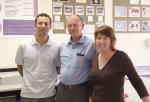Identification a matter of record for tsunami dentists
 Dentistry Dentistry
DNA evidence might reign supreme on prime-time TV, but it was dental identification that was the dominant method of identifying victims of the Boxing Day Tsunami - with the University of Adelaide playing its part. By May 2005, forensic odontology (or forensic dentistry) had contributed to 87% of identifications, 9% of victims had been identified by their fingerprints and only 0.5% by DNA evidence, which is called into play later in the identification process due to cost factors. Forensic odontologists from the University of Adelaide's School of Dentistry have spent eight months across 2005 travelling to Thailand to identify tsunami victims through their dental records. From January, the team - Dr Helen James, Dr Giacomo Cirillo, Dr Tony Lake and Dr Kain Rowlings - joined other Australian and international forensic odontologists at the coalface of the tragedy, putting in 12-hour shifts at temporary mortuaries, comparing dental structures to records held in an international database (Plassdata, based in Denmark). Dr Helen James, Acting Director of the Forensic Odontology Unit, described it as a "surreal experience". "From the first report of 4,500 victims, the bodies to be identified just kept on coming," she said. "We were working with teams of forensic dentists from Thailand and other Asian countries, New Zealand, Europe, UK and Canada. We had to create a mortuary and implement a number of processes for disease control as well as information management systems under very difficult situations. "Identifying the victims is a process of pattern association and you quickly discover the search is only as good as the data that has been entered. Identification of very young victims who were yet to have seen a dentist was particularly difficult, but we could estimate their age from the stage of dental development. "Australian involvement in the operation is now winding down. There were very few Australian victims from here, but, like a number of other countries, we stayed on for the long haul and this has been greatly appreciated by the Thais and other countries more greatly affected. Australian teams made a huge contribution to the identification effort, which still continues, with about 1000 bodies still to be identified. "Every disaster is different and we have learnt a lot from working in such large teams from all over the world. We have developed new techniques and we've gained important experience for the future." The University of Adelaide's Forensic Odontology team usually works on about 100 cases every year, mostly local identification problems, but also bitemark analysis from crime scenes, age estimates and photographic superimpositions. "The job requires lateral thinking, an awareness of procedural aspects of the work and the potential legal outcomes from your results," Dr James said. "The fact that CSI can sort it out over an ad break is not realistic. This style of TV show has, however, increased student interest in all areas of forensic science. To my mind it is the most interesting area of dentistry, but in no way is it the most lucrative." The Forensic Odontology Unit has been involved with most major crimes or disasters that have taken place in South Australia over the past 25 years, including this year's bushfires on the Eyre Peninsula, the "Bodies in the Barrels" cases and the Truro Murders. Forensic dentistry makes up part of the undergraduate course at the School of Dentistry, with lectures to all years of study and a one-week intensive selective for final-year dental students. There will be three postgraduate students pursuing the specialty in 2006. Story by Lisa Reid
|





